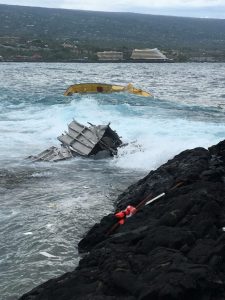NOAA Releases 2016 Hurricane Season Summary
NOAA released its 2016 Central Pacific Basin Hurricane summary earlier today.
The 2016 hurricane season, which officially began on June 1 and ended on Dec. 1, featured 6 tropical cyclones, which is slightly above the seasonal average.
The 2016 hurricane season was marked by a rapid springtime transition from the 2015 El Nino to a weak La Nina condition by the end of the season.
There was one direct landfall to the state of Hawai‘i, and several close calls which featured indirect impacts to the state during the first half of the season, but generally quiet conditions prevailed during the last half of the season.
Impacts to the State of Hawai‘i:
On July 23, 2016, Tropical Storm Darby made landfall on the southeast coastline of the Big Island, close to Pahala in the Kau District.
Darby was a weakening tropical storm at landfall with maximum winds near 40 mph.
Tropical Storm Darby continued west of the Big Island, moving toward the northwest as it navigated the Kaua‘i Channel.
Even though the center of Darby missed both O‘ahu and Kaua‘i during transit, some of the worst impacts from Darby were felt on O‘ahu as a band of torrential rainfall set up over metro Honolulu for several hours on July 24.
Darby also impacted the coastal area of the Big Island near Kapoho where several low lying areas became inundated.
Two nearby passing tropical cyclones, Hurricanes Madeline and Lester in late August through early September, brought pounding high surf and some coastal erosion to some east facing shores.
Most notable erosion impacts were to the windward O‘ahu sections of Kamehameha Highway, resulting in temporary or partial lane closures.
The following outlines tropical cyclone names and highest classification, lifecycle dates and maximum wind speeds while in the central Pacific basin.
Hurricane Pali – Jan. 7-15 – Maximum Wind 100 mph
Tropical Storm Celia – July 15-16 – Maximum Wind 45 mph
Tropical Storm Darby – July 20-26 -Maximum Wind 65 mph
Tropical Depression Ivette – Aug. 8 – Maximum Wind 35 mph
Hurricane Madeline – Aug. 28-Sept. 3 – Maximum Wind 135 mph
Hurricane Lester – Sept. 1-7- Maximum Wind 135 mph
Tropical Storm Ulika – Sept. 27-30 – Maximum Wind 50 mph
The 7 tropical cyclones in the Central Pacific in calendar year 2016 (6 during hurricane season, 1 out of season) was above the normal 4 to 5 tropical cyclones that develop or move across the central Pacific basin each year.
Hurricane Hunter missions:
The United States Air Force Reserve’s 53rd Weather Reconnaissance Squadron, flew 14 total missions constituting 110 hours of operational flying time in the central Pacific in 2016.
These missions were flown in support of forecasting operations for Tropical Storm Darby, Hurricane Madeline and Hurricane Lester, gathering extremely valuable weather data on the tropical cyclones which threatened the State of Hawai‘i.
In addition, the NOAA Aircraft Operations Center Hurricane Hunters flew 3 high level weather surveillance missions on Hurricane Lester to help ascertain the large scale atmospheric conditions which would influence the cyclones track.
















